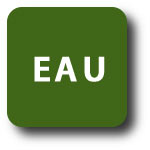STOCKHOLM, SWEDEN (UroToday.com) - In this plenary session, Dr. J. A. Witjes spoke about the use and importance of adjuvant treatment of non-muscle-invasive bladder cancer (NMIBC).
The moderator, Dr. M. Babjuk, from Prague, presented a case of a 70-year-old patient who initially presented with gross hematuria and on transurethral resection of bladder tumor (TURBT) was diagnosed with high grade T1 urothelial carcinoma of the bladder. The aim of this plenary session was for the experts (Drs. E. Comperat, S. F. Shariat, and J. A. Witjes) to discuss the algorithms and details in performance of initial steps in the treatment of NMIBC.
 Dr. Witjes opened his talk by emphasizing the importance of an initial, aggressive, endoscopic procedure (TURBT), and (a must) subsequent re-stage TURBT, to minimize the risk of under staging and to maximize the potential for cure. He stated that for patients with "intermediate risk", one immediate instillation of chemotherapy followed by further instillations of either full dose BCG or mitmycin C for 1 year. In regards to adjuvant treatments for "high risk" patients (T1 high grade, presence of CIS, multiple and recurrent high grade Ta disease), once again postoperative chemo + intravesical full dose BCG instillation for 1 to 3 years is necessary. Furthermore, for "low risk" patients (solitary Ta low grade, < 3 cm, no CIS), evidence for post surgery chemotherapy instillation is limited, but it has been shown that it reduces the chance of recurrence almost by half. He stated that an immediate instillation is level 1 evidence, but only the true low-risk patients seem to benefit from it. For patients who are considered "BCG failures," although new chemptherapeutics are slowly coming, the current recommended second line therapies are BCG/IFN-alpha, intravesical chemo-hyperthermia, or gemcitabin. In regards to gemcitabin's therapeutic potential, he presented the data from Cochrane Reviews which consisted of 6 trials (704 patients), of which 3 of the trials compared its effect to BCG. Results from this review show that, compared to BCG, although gemcitabin has a similar effect in patients with "intermediate risk", it is less effective in high-risk patients and is superior in BCG-refractory patients. Even though the evidence from this large review is limited due to differences in clinical settings, it demonstrates that gemcitabin has potential in the therapeutic management of BCG-refractory patients.
Dr. Witjes opened his talk by emphasizing the importance of an initial, aggressive, endoscopic procedure (TURBT), and (a must) subsequent re-stage TURBT, to minimize the risk of under staging and to maximize the potential for cure. He stated that for patients with "intermediate risk", one immediate instillation of chemotherapy followed by further instillations of either full dose BCG or mitmycin C for 1 year. In regards to adjuvant treatments for "high risk" patients (T1 high grade, presence of CIS, multiple and recurrent high grade Ta disease), once again postoperative chemo + intravesical full dose BCG instillation for 1 to 3 years is necessary. Furthermore, for "low risk" patients (solitary Ta low grade, < 3 cm, no CIS), evidence for post surgery chemotherapy instillation is limited, but it has been shown that it reduces the chance of recurrence almost by half. He stated that an immediate instillation is level 1 evidence, but only the true low-risk patients seem to benefit from it. For patients who are considered "BCG failures," although new chemptherapeutics are slowly coming, the current recommended second line therapies are BCG/IFN-alpha, intravesical chemo-hyperthermia, or gemcitabin. In regards to gemcitabin's therapeutic potential, he presented the data from Cochrane Reviews which consisted of 6 trials (704 patients), of which 3 of the trials compared its effect to BCG. Results from this review show that, compared to BCG, although gemcitabin has a similar effect in patients with "intermediate risk", it is less effective in high-risk patients and is superior in BCG-refractory patients. Even though the evidence from this large review is limited due to differences in clinical settings, it demonstrates that gemcitabin has potential in the therapeutic management of BCG-refractory patients.
He concluded the presentation by emphasizing three points: urologists and pathologists should cooperate closely, the quality of TRUB is crucial for patient outcome, and finally the algorithm after TURB depends on the risk stratification.
Presented by J. A. Witjes at the 29th Annual European Association of Urology (EAU) Congress - April 11 - 15, 2014 - Stockholmsmässan - Stockholm, Sweden.
Nijmegen, The Netherlands
Written by Reza Mehrazin, MD, medical writer for UroToday.com


